The MSI X99A Gaming Pro Carbon Motherboard Review
by Ian Cutress on February 6, 2017 9:00 AM EST- Posted in
- Motherboards
- Gaming
- MSI
- X99
- X99A Gaming Pro Carbon
System Performance
Not all motherboards are created equal. On the face of it, they should all perform the same and differ only in the functionality they provide - however this is not the case. The obvious pointers are power consumption, but also the ability for the manufacturer to optimize USB speed, audio quality (based on audio codec), POST time and latency. This can come down to manufacturing process and prowess, so these are tested.
Power Consumption
Power consumption was tested on the system while in a single MSI GTX 770 Lightning GPU configuration with a wall meter connected to the OCZ 1250W power supply. This power supply is Gold rated, and as I am in the UK on a 230-240 V supply, leads to ~75% efficiency > 50W, and 90%+ efficiency at 250W, suitable for both idle and multi-GPU loading. This method of power reading allows us to compare the power management of the UEFI and the board to supply components with power under load, and includes typical PSU losses due to efficiency. These are the real world values that consumers may expect from a typical system (minus the monitor) using this motherboard.
While this method for power measurement may not be ideal, and you feel these numbers are not representative due to the high wattage power supply being used (we use the same PSU to remain consistent over a series of reviews, and the fact that some boards on our test bed get tested with three or four high powered GPUs), the important point to take away is the relationship between the numbers. These boards are all under the same conditions, and thus the differences between them should be easy to spot.
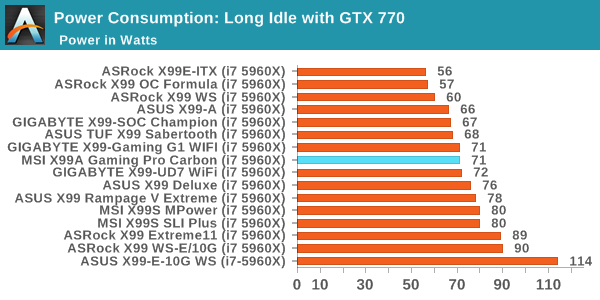

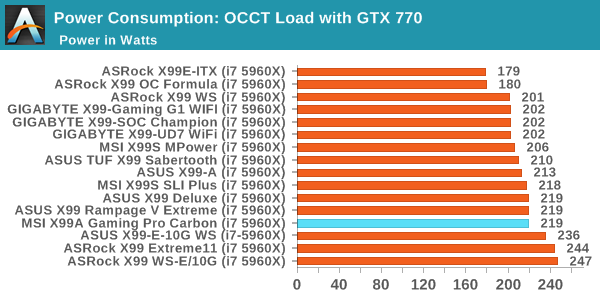
The MSI falls fairly mid-range on power consumption, but at the top-middle of the stack when run at full force.
Non-UEFI POST Time
Different motherboards have different POST sequences before an operating system is initialized. A lot of this is dependent on the board itself, and POST boot time is determined by the controllers on board (and the sequence of how those extras are organized). As part of our testing, we look at the POST Boot Time using a stopwatch. This is the time from pressing the ON button on the computer to when Windows 7 starts loading. (We discount Windows loading as it is highly variable given Windows specific features.)
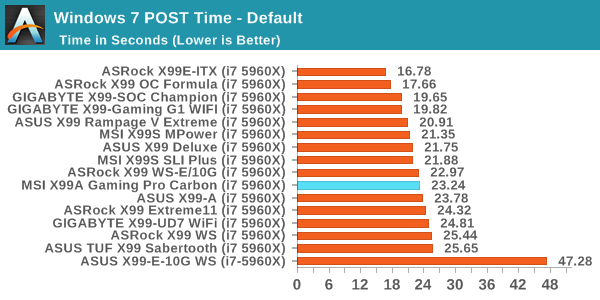
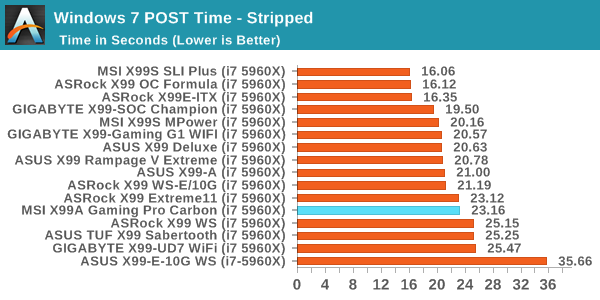
X99 has always been fairly odd with POST times, with only a few boards getting under 20 seconds. The MSI sits between that 20-25 boundary where most X99 boards seem to be.
Rightmark Audio Analyzer 6.2.5
Rightmark:AA indicates how well the sound system is built and isolated from electrical interference (either internally or externally). For this test we connect the Line Out to the Line In using a short six inch 3.5mm to 3.5mm high-quality jack, turn the OS speaker volume to 100%, and run the Rightmark default test suite at 192 kHz, 24-bit. The OS is tuned to 192 kHz/24-bit input and output, and the Line-In volume is adjusted until we have the best RMAA value in the mini-pretest. We look specifically at the Dynamic Range of the audio codec used on board, as well as the Total Harmonic Distortion + Noise.
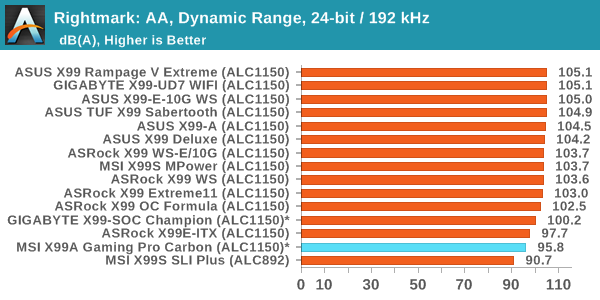
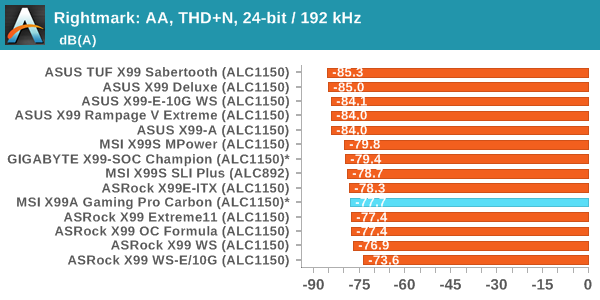
Despite the use of the ALC1150, the bundled Nahimic software and driver setup can not be switched off altogether. As a result we don't particularly get a clear reading on the core audio hardware performance.
USB Backup
For this benchmark, we transfer a set size of files from the SSD to the USB drive using DiskBench, which monitors the time taken to transfer. The files transferred are a 1.52 GB set of 2867 files across 320 folders – 95% of these files are small typical website files, and the rest (90% of the size) are small 30 second HD videos. In an update to pre-Z87 testing, we also run MaxCPU to load up one of the threads during the test which improves general performance up to 15% by causing all the internal pathways to run at full speed.
Due to the introduction of USB 3.1, as of June 2015 we are adjusting our test to use a dual mSATA USB 3.1 Type-C device which should be capable of saturating both USB 3.0 and USB 3.1 connections. We still use the same data set as before, but now use the new device. Results are shown as seconds taken to complete the data transfer.
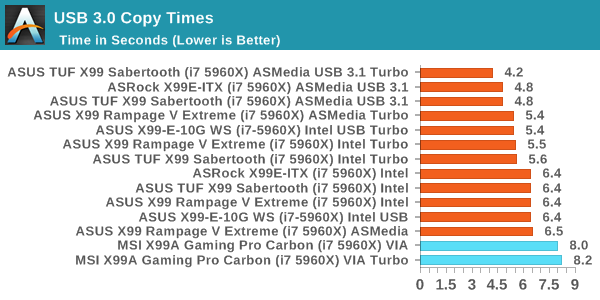
The VIA VL805 hub used for the rear panel USB 3.0 ports adds in overhead for our copy test. The fact that the Turbo mode gave a lower score is cause for concern as well.
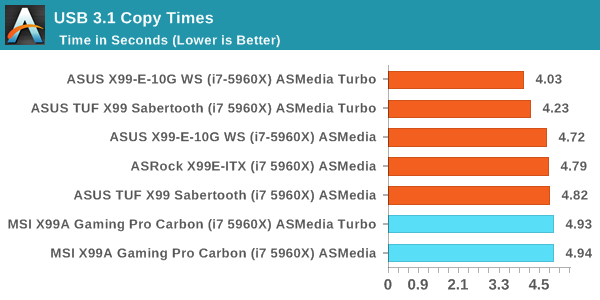
MSI's USB 3.1 speeds were at the back of our newer test on the X99 refresh boards, but only by a small margin.
DPC Latency
Deferred Procedure Call latency is a way in which Windows handles interrupt servicing. In order to wait for a processor to acknowledge the request, the system will queue all interrupt requests by priority. Critical interrupts will be handled as soon as possible, whereas lesser priority requests such as audio will be further down the line. If the audio device requires data, it will have to wait until the request is processed before the buffer is filled.
If the device drivers of higher priority components in a system are poorly implemented, this can cause delays in request scheduling and process time. This can lead to an empty audio buffer and characteristic audible pauses, pops and clicks. The DPC latency checker measures how much time is taken processing DPCs from driver invocation. The lower the value will result in better audio transfer at smaller buffer sizes. Results are measured in microseconds.
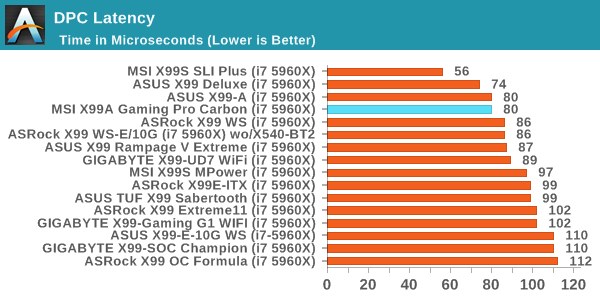
The last platform to get truly low DPC latency numbers on most of the boards was Z97, but X99 is close. Almost all the X99 motherboards we have tested get under 100 microseconds, and MSI seems to be understanding their results in this test over time.










37 Comments
View All Comments
The_Assimilator - Monday, February 6, 2017 - link
Good to see someone else still rocking a TRUE Copper! :DLiquidSilverZ - Monday, February 6, 2017 - link
Love my Ultra 120 Extreme! Still keeps my i7-2600K @4.8GHz, <60C at stock voltage, no problem!shabby - Monday, February 6, 2017 - link
Ridiculous... $330 and it doesn't have eXtreme in the name?!?Shadowmaster625 - Monday, February 6, 2017 - link
jesus, those prices are flat-out absurd and insane.GoMoeJoe - Tuesday, February 7, 2017 - link
Recognizing this review is a tad bit late, I still appreciate having it now.This MSI offering spanks the 'Godlike' Carbon with the integrated Killer Network hardware.
If you're seeking a true X99A performer, do yourself a favor and save some coin -
skip the 'Godlike' and buy this.
Barens - Wednesday, February 15, 2017 - link
I just found this amazing graphic video and play to all games now! Price is too much, but is amazinghttp://trucchia360gradi.net/
gamingtoolkit - Friday, September 8, 2017 - link
The MSI X99A Gaming Pro Carbon Motherboard is a very professionally designed motherboard for the gaming. happy to see the reviews here. the reviews are same as expected.http://gamingtoolkit.net/